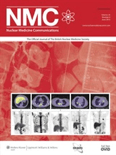
NUCLEAR MEDICINE COMMUNICATIONS
Scope & Guideline
Transforming Patient Care Through Nuclear Insights
Introduction
Aims and Scopes
- Nuclear Imaging Techniques:
The journal emphasizes the development and application of various nuclear imaging techniques, including PET (Positron Emission Tomography), SPECT (Single Photon Emission Computed Tomography), and hybrid modalities like PET/CT. These techniques are crucial for diagnosing and monitoring diseases, particularly cancers. - Radiopharmaceutical Research:
Research on the synthesis, optimization, and clinical application of radiopharmaceuticals is a core focus. The journal publishes studies on novel radiotracers and their potential therapeutic applications, enhancing the field of targeted therapy. - Quantitative Imaging and Analysis:
The journal highlights the importance of quantitative imaging methods and radiomics in enhancing diagnostic accuracy and prognostic assessment. Studies often involve texture analysis, volumetric measurements, and machine learning applications. - Clinical Applications and Guidelines:
The journal disseminates clinical studies and guidelines that inform best practices in nuclear medicine. This includes the evaluation of imaging techniques for various cancers, the role of nuclear medicine in treatment planning, and the management of side effects. - Safety and Dosimetry:
Research focused on the safety, biodistribution, and dosimetry of radiological agents is also prevalent. This contributes to the understanding of radiation exposure and its effects, ensuring patient safety during nuclear medicine procedures.
Trending and Emerging
- Machine Learning and AI in Nuclear Medicine:
There is a growing trend towards incorporating machine learning and artificial intelligence in nuclear medicine. This includes using AI for image analysis, predictive modeling, and improving diagnostic accuracy, thus enhancing the efficiency of clinical decision-making. - Radiomics and Advanced Imaging Analytics:
The use of radiomics, which involves extracting large amounts of features from medical images, is increasingly prevalent. This trend underscores the shift towards personalized medicine, where imaging data can predict treatment responses and outcomes. - Theranostics and Personalized Therapy:
A significant increase in studies focusing on theranostics—an approach that combines diagnostics and therapeutics—is observed. This reflects a broader move towards personalized treatment strategies, particularly in oncology, where targeted therapies are tailored to individual patient profiles. - Integration of Hybrid Imaging Techniques:
The integration of hybrid imaging techniques, such as PET/MRI and advanced SPECT/CT methodologies, is trending. These approaches provide comprehensive diagnostic information, improving the characterization of tumors and aiding in treatment planning. - Focus on Patient Safety and Dosimetry:
There is an emerging focus on patient safety, radiation protection, and dosimetry in nuclear medicine. Research is increasingly addressing the need for minimizing radiation exposure while maximizing diagnostic and therapeutic benefits.
Declining or Waning
- Traditional Imaging Techniques:
There is a noticeable decline in studies focused on traditional imaging techniques, such as planar scintigraphy, as advanced modalities like PET/CT and SPECT/CT gain prominence. This shift indicates a preference for more sophisticated imaging methods that provide better diagnostic accuracy. - General Nuclear Medicine Practices:
Papers detailing general nuclear medicine practices without a specific focus on innovative techniques or clinical applications are becoming less frequent. This reflects a trend towards more specialized and targeted research that contributes directly to advancements in the field. - Non-specific Radiopharmaceuticals:
Research on non-specific radiopharmaceuticals (those not targeting specific receptors or pathways) has decreased. The current trend favors the development of targeted therapies that enhance treatment effectiveness and minimize side effects.
Similar Journals

QUARTERLY JOURNAL OF NUCLEAR MEDICINE AND MOLECULAR IMAGING
Elevating Research in Nuclear Medicine and Imaging.The Quarterly Journal of Nuclear Medicine and Molecular Imaging, published by Edizioni Minerva Medica in Italy, serves as a pivotal platform for researchers and practitioners in the fields of Nuclear Medicine and Molecular Imaging. With an ISSN of 1824-4785 and an E-ISSN of 1827-1936, this journal boasts a respectable impact factor and is positioned in the Q3 quartile of the Radiology, Nuclear Medicine and Imaging category, based on the latest 2023 evaluations. As the journal continues to converge from its inception in 2004 to its anticipated expansions through 2024, it aims to disseminate high-quality, peer-reviewed articles that advance the frontier of imaging technologies and their applications in clinical practice. Researchers, professionals, and students are encouraged to contribute to its diverse scope, which encompasses innovative research, clinical findings, and reviews that encapsulate cutting-edge advancements in the field, highlighting its importance as an essential resource for knowledge and collaboration.
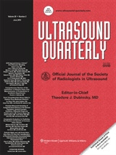
Ultrasound Quarterly
Empowering Radiology Innovation.Ultrasound Quarterly is a leading journal published by Lippincott Williams & Wilkins, dedicated to advancing knowledge and practice in the fields of radiology, nuclear medicine, and imaging. Established in 1988, the journal has served as a vital platform for researchers, clinicians, and students seeking to stay abreast of the latest advancements and techniques in ultrasound technology. With an impact factor that reflects its significance in the field—ranking in the Q3 category within its specialty based on the 2023 metrics—this journal reaches a global audience, facilitating knowledge dissemination and fostering innovation. Ultrasound Quarterly publishes original research, reviews, and clinical studies, making it an essential resource for professionals committed to enhancing patient care through effective imaging practices. To explore its comprehensive articles, visit the journal's website for easy access to the latest research findings.

Nuclear Medicine and Molecular Imaging
Pioneering Discoveries in Molecular Imaging TechniquesNuclear Medicine and Molecular Imaging, published by SPRINGER HEIDELBERG, stands as a pivotal platform in the interdisciplinary field of radiology and nuclear medicine, focusing on innovative research and developments from 2010 to 2024. With its ISSN 1869-3474 and E-ISSN 1869-3482, this journal aims to disseminate advanced studies that explore the diagnostic and therapeutic applications of nuclear medicine technologies. Operating from Germany, it has positioned itself in the Q3 category within the Radiology, Nuclear Medicine and Imaging sector, showcasing its relevance among peer journals, with a Scopus rank of #204 out of 333. This journal not only serves as an essential resource for researchers and practitioners eager to stay abreast of modern methodologies and findings but also underscores the crucial advancements in molecular imaging techniques. Although currently not an open-access journal, it doesn't detract from its mission to promote knowledge exchange among academia and the medical community, thus paving the way for innovative solutions and improved patient care in nuclear medicine.

American Journal of Nuclear Medicine and Molecular Imaging
Exploring New Horizons in Nuclear Medicine ResearchThe American Journal of Nuclear Medicine and Molecular Imaging (ISSN: 2160-8407), published by E-CENTURY PUBLISHING CORP, is a distinguished platform for the dissemination of cutting-edge research in the fields of nuclear medicine and molecular imaging. With a commitment to advancing scientific inquiry and clinical applications, this journal serves as a vital resource for researchers, clinicians, and students dedicated to exploring innovative imaging modalities, radiopharmaceuticals, and their applications in diagnosing and treating various medical conditions. Although currently not available as an open-access journal, this publication plays a crucial role in fostering academic dialogue and collaboration within the medical community. Its diverse range of topics and expert contributions underscore its impact in bridging the gap between research findings and clinical practice, making it an essential read for anyone interested in the rapidly evolving landscape of nuclear medicine and imaging technologies.
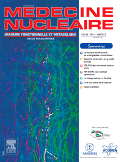
Medecine Nucleaire-Imagerie Fonctionnelle et Metabolique
Unveiling the Science Behind Nuclear Medicine.Medicine Nucleaire-Imagerie Fonctionnelle et Metabolique is a prominent journal published by Elsevier France-Editions Scientifiques Medicales Elsevier, dedicated to the specialized fields of nuclear medicine and functional imaging. With an ISSN of 0928-1258 and an E-ISSN of 1878-6820, this esteemed publication has been a crucial platform for the dissemination of research and developments in the discipline since its inception in 1993. Covering a wide array of topics within biophysics, radiological and ultrasound technology, and radiology, the journal currently holds a Q4 category ranking in these fields, reflecting its significance within the academic community. Although there are currently no open access options available for readers, the journal caters to a niche audience of researchers, professionals, and students who seek to enhance their understanding of metabolic imaging and its applications. The 2023 Scopus ranks indicate its position as an emerging source of knowledge in a competitive landscape, making it an important resource for the latest studies and innovations in nuclear medicine.
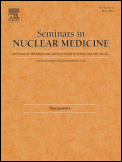
SEMINARS IN NUCLEAR MEDICINE
Empowering healthcare with cutting-edge insights.Welcome to Seminars in Nuclear Medicine, a prestigious journal published by W B Saunders Co-Elsevier Inc that has been at the forefront of the field since its inception in 1971. This journal serves as a dedicated forum for researchers, healthcare professionals, and students specializing in the rapidly evolving areas of radiology and nuclear medicine. With an impressive ranking of #29 out of 333 in the Scopus category, drawing an esteemed 91st percentile, it holds a distinguished Q1 category status, highlighting its critical role in disseminating high-quality research and clinical practices. Although it does not operate as an Open Access publication, Seminars in Nuclear Medicine remains a vital resource, featuring comprehensive reviews and insightful articles that inform the medical community about the latest advancements and applications within nuclear imaging. This journal not only enhances knowledge but also encourages collaboration among professionals dedicated to improving patient outcomes through innovative nuclear medicine techniques.

NUCLEAR MEDICINE REVIEW
Elevating Standards in Nuclear Medicine ResearchNUCLEAR MEDICINE REVIEW is a distinguished journal in the field of radiology, nuclear medicine, and imaging, published by VIA MEDICA in Poland. Since its transition to an open access format in 1999, this journal has been dedicated to promoting the dissemination of knowledge and research findings across a global audience. With a focus on innovative approaches and advancements in nuclear medicine, it aims to serve as a key resource for researchers, professionals, and students who are working to further the understanding of nuclear imaging and its applications. In 2023, the journal was classified in the Q3 category within Radiology, Nuclear Medicine and Imaging, and Q4 in the broader category of Medicine (miscellaneous), highlighting its growing reputation in the academic community. As of the latest assessments, the journal has been ranked #235 out of 333 in its field according to Scopus metrics, reflecting its commitment to excellence and the relevance of its published works. The NUCLEAR MEDICINE REVIEW is a pivotal platform for those engaged in cutting-edge research, providing insights that drive the evolution of medical imaging and therapeutic techniques.

ANNALS OF NUCLEAR MEDICINE
Championing Progress in Radiology and Nuclear MedicineANNALS OF NUCLEAR MEDICINE is a prominent academic journal dedicated to the field of nuclear medicine, published by Springer. With a rich publication history dating back to 1987 and continuing through 2024, this journal serves as a vital resource for researchers and practitioners interested in the latest developments in nuclear imaging, radiopharmaceuticals, and therapeutic applications. Ranked in the second quartile (Q2) for both Medicine (miscellaneous) and Radiology, Nuclear Medicine, and Imaging categories in 2023, it maintains a strong position in the academic community, with an impressive Scopus rank of #104 out of 333 in its field, placing it in the 68th percentile. The journal is not open access but offers a range of access options through institutional or individual subscriptions, ensuring that critical research findings reach a wide audience. By fostering high-quality, peer-reviewed articles, ANNALS OF NUCLEAR MEDICINE plays a crucial role in advancing the understanding and practical application of nuclear medicine techniques, making it an essential journal for professionals and students aiming to stay at the forefront of this evolving discipline.
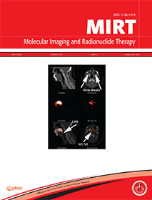
Molecular Imaging and Radionuclide Therapy
Pioneering discoveries in the realm of nuclear medicine.Molecular Imaging and Radionuclide Therapy is an esteemed academic journal published by GALENOS PUBL HOUSE, dedicated to advancing the fields of radiology, nuclear medicine, and imaging. Since its inception, this Open Access journal has facilitated the dissemination of high-quality research and innovative practices in molecular imaging and radionuclide therapy, making it a vital resource for researchers, professionals, and students alike. With an ISSN of 2146-1414 and an E-ISSN of 2147-1959, the journal has established its presence globally while specifically catering to the Turkish academic and medical community. As of 2023, it is ranked #241/333 in the Radiology, Nuclear Medicine and Imaging category on Scopus, holding a respectable Q3 quartile ranking. The journal serves as a platform for sharing impactful findings from 2017 to 2024, reinforcing its commitment to open access since 2011. With a dedication to enhancing the knowledge base in molecular imaging and therapy, it remains an important conduit for scholarly communication and collaborative research developments in this dynamic field.

Current Radiology Reports
Elevating clinical practice through innovative radiology reports.Current Radiology Reports is an esteemed journal published by SPRINGERNATURE, focusing on the dynamic field of radiology, nuclear medicine, and imaging. With a commitment to advancing knowledge and promoting innovative practices, this journal serves as a valuable resource for researchers, healthcare professionals, and students striving to stay at the forefront of radiological advancements. Featuring an impressive impact factor and recognized as a Q3 journal within its category as of 2023, it highlights critical developments and comprehensive reviews that inform clinical practice and research methodologies. Although it operates under a subscription model, the journal provides a rich repository of peer-reviewed content, covering a wide range of topics from diagnostic imaging to therapeutic applications. With a publication span from 2013 to 2024, Current Radiology Reports continues to uphold its reputation as a leading publication critical for anyone involved in the radiology profession.